St Katharine's Hospital (American Red Cross
Military Hospital No. 23)
Military Hospital No. 23)
St Katharine's Precinct, Regent's Park, NW1 4HH
Medical dates:
Medical character:
Almshouse
During the 12th century it was a
religious duty to perform works of mercy. St Bartholomew's and St
Thomas' Hospitals were established for the care of the sick, other
hospitals for the care of lepers, and yet others for the relief of the
poor.
The Royal Hospital and Collegiate Church of St Katharine by the Tower was founded in 1148 by Matilda of Boulogne, Queen of King Stephen, for the maintenance of 13 'poor persons' in memory of her two dead infant children and for the benefit of her soul. Never a medical hospital, it was rather an ecclesiastical corporation, providing spiritual and bodily care for the poor.
Thirteen was the usual endowment of such early hospitals, which usually consisted of a Master (a valuable sinecure), 3 priests (Brothers), 3 Sisters and 6 poor assistants.
St Katharine's Hospital was well paid by the Dock Company for the loss of its site - £125,000 for the Precinct as well as £2000 for the purchase of the new site at the northeast corner of Regent's Park, and £30,000 for the new buildings.
The new Royal Hospital of St Katharine opened in 1827. There were three residences for the Brothers at the north of the site and three for the Sisters at the south, with a chapel between them. The chapel, built between 1826-28, contained much from the old buildings. The Master's House and garden occupied two acres of land opposite the Hospital. A school was also built to educate children aged between 7 -14 years from impoverished families.
While the Hospital had survived with an unchanged constitution, it lost prestige. It became a kind of 'aristocratic almshouse for the support by Royal bounty of certain well-born persons of narrow means' - the grace-and-favour arrangement of Hampton Court Palace but with clerical input.
In 1887 the Queen Victoria Jubilee Institute for Nurses - for the training and supervision of district nurses - was based at the Hospital.
During WW1 the then Patron Queen Alexandra, the Queen Mother, granted the use of the Regent's Park Chapel to her fellow Danes in London. The Master's House (now St Katharine's Lodge) became available for leasing.
In June 1917 the wife of the American tenant, Mr William Salomon, a banker from New York, offered St Katharine's Lodge to the London Chapter of the American Red Cross for use as a hospital for officers. Until such a time that it was needed for American officers, it was decided to make the hospital an auxiliary to the Military Orthopaedic Hospital at Shepherd's Bush. In addition to adapting the residence structurally to the needs of a hospital, Mrs Salomon equipped it and paid for its maintenance.
The St Katharine's Lodge Hospital was officially opened by Mr Page, the American Ambassador. It had been quickly fitted with 30 beds and the first patients arrived on 1st August 1917.
Later, it had 44 beds. The largest ward had 12 beds, while others had six, five, four or two, and there was one single room. The walls on the ground floor were painted grey, while those on the first floor were biscuit-coloured; the others were blue and white. The floors were covered in blue linoleum, and the white beds with blue eiderdowns. The white lockers had electric lamps with blue shades. The frames of the screens were painted white and had blue poplin panels. Table tops were composed of blue and white tiles.
The operating theatre was well-equipped and well-lit. A mirror placed outside one window, and hung at an angle, caught and reflected the light back into the room - a device frequently found in American hospitals. The Hospital also had a massage and electrical department, as well as a gymnasium. There was excellent bathroom accommodation and the building was centrally heated. American women living in London supplied pyjamas and dressing gowns for the patients, who were mainly British officers at first. Later, American patients were also received.
The resident medical officers were from the American Red Cross who had recently been attached to the Military Orthopaedic Hospital. The Matron was also from the American Red Cross; she wore a simple white poplin dress and a regulation close-fitting cap with a small Red Cross in front, and white stockings and shoes. The eight registered American nurses wore grey dresses. Members of the VADs worked in the kitchen or answered the door or the telephone.
On 1st January 1918 the Hospital was transferred to the control of the American Red Cross Commission for Great Britain. It was then designated the American Red Cross Military Hospital No. 23. It was staffed by 11 American Red Cross nurses. The Hospital had 38 beds, which continued to be used for the care of British officers.
In the midsummer of 1918 the Hospital was militarized and became a ward for American officers of the United States Army Base Hospital No. 29, which had been established at the North Eastern Hospital in Tottenham.
The Hospital closed after the war. It had been a great success, located as it was in the spacious lawns and gardens of Regent's Park. The peace and quiet of the park, broken only by birdsong, aided recovery. The park's squirrels would even enter the wards looking for tasty morsels from the patients' trays.
In 1919, the West End Hospital for Nervous Diseases took over the building.
The Royal Hospital and Collegiate Church of St Katharine by the Tower was founded in 1148 by Matilda of Boulogne, Queen of King Stephen, for the maintenance of 13 'poor persons' in memory of her two dead infant children and for the benefit of her soul. Never a medical hospital, it was rather an ecclesiastical corporation, providing spiritual and bodily care for the poor.
Thirteen was the usual endowment of such early hospitals, which usually consisted of a Master (a valuable sinecure), 3 priests (Brothers), 3 Sisters and 6 poor assistants.
St Katharine's Hospital was well paid by the Dock Company for the loss of its site - £125,000 for the Precinct as well as £2000 for the purchase of the new site at the northeast corner of Regent's Park, and £30,000 for the new buildings.
The new Royal Hospital of St Katharine opened in 1827. There were three residences for the Brothers at the north of the site and three for the Sisters at the south, with a chapel between them. The chapel, built between 1826-28, contained much from the old buildings. The Master's House and garden occupied two acres of land opposite the Hospital. A school was also built to educate children aged between 7 -14 years from impoverished families.
While the Hospital had survived with an unchanged constitution, it lost prestige. It became a kind of 'aristocratic almshouse for the support by Royal bounty of certain well-born persons of narrow means' - the grace-and-favour arrangement of Hampton Court Palace but with clerical input.
In 1887 the Queen Victoria Jubilee Institute for Nurses - for the training and supervision of district nurses - was based at the Hospital.
During WW1 the then Patron Queen Alexandra, the Queen Mother, granted the use of the Regent's Park Chapel to her fellow Danes in London. The Master's House (now St Katharine's Lodge) became available for leasing.
In June 1917 the wife of the American tenant, Mr William Salomon, a banker from New York, offered St Katharine's Lodge to the London Chapter of the American Red Cross for use as a hospital for officers. Until such a time that it was needed for American officers, it was decided to make the hospital an auxiliary to the Military Orthopaedic Hospital at Shepherd's Bush. In addition to adapting the residence structurally to the needs of a hospital, Mrs Salomon equipped it and paid for its maintenance.
The St Katharine's Lodge Hospital was officially opened by Mr Page, the American Ambassador. It had been quickly fitted with 30 beds and the first patients arrived on 1st August 1917.
Later, it had 44 beds. The largest ward had 12 beds, while others had six, five, four or two, and there was one single room. The walls on the ground floor were painted grey, while those on the first floor were biscuit-coloured; the others were blue and white. The floors were covered in blue linoleum, and the white beds with blue eiderdowns. The white lockers had electric lamps with blue shades. The frames of the screens were painted white and had blue poplin panels. Table tops were composed of blue and white tiles.
The operating theatre was well-equipped and well-lit. A mirror placed outside one window, and hung at an angle, caught and reflected the light back into the room - a device frequently found in American hospitals. The Hospital also had a massage and electrical department, as well as a gymnasium. There was excellent bathroom accommodation and the building was centrally heated. American women living in London supplied pyjamas and dressing gowns for the patients, who were mainly British officers at first. Later, American patients were also received.
The resident medical officers were from the American Red Cross who had recently been attached to the Military Orthopaedic Hospital. The Matron was also from the American Red Cross; she wore a simple white poplin dress and a regulation close-fitting cap with a small Red Cross in front, and white stockings and shoes. The eight registered American nurses wore grey dresses. Members of the VADs worked in the kitchen or answered the door or the telephone.
On 1st January 1918 the Hospital was transferred to the control of the American Red Cross Commission for Great Britain. It was then designated the American Red Cross Military Hospital No. 23. It was staffed by 11 American Red Cross nurses. The Hospital had 38 beds, which continued to be used for the care of British officers.
In the midsummer of 1918 the Hospital was militarized and became a ward for American officers of the United States Army Base Hospital No. 29, which had been established at the North Eastern Hospital in Tottenham.
The Hospital closed after the war. It had been a great success, located as it was in the spacious lawns and gardens of Regent's Park. The peace and quiet of the park, broken only by birdsong, aided recovery. The park's squirrels would even enter the wards looking for tasty morsels from the patients' trays.
In 1919, the West End Hospital for Nervous Diseases took over the building.
Present status (July 2008)
Nothing remains of St Katharine's Lodge, which was destroyed by bombs during WW2.
St Katharine's Dock closed in 1968 when larger ships came into use after the War and moved downstream to Tilbury. The Dock never produced the large profits for which it had been built. The 24 acre site was sold to the Greater London Council and now contains the World Trade Centre and a marina with a collection of historic vessels. The warehouses have been converted into apartments and the area has become highly fashionable.
Plans for the Hospital buildings in Regent's Park to became a religious college fell through because of ethical and geographical problems. The terraced buildings are now Grade II* listed private residences of 4 bedrooms and 4 reception rooms each, commanding a typical purchase price of £10m.
The Chapel has become the Danish Church of St Katharine.Nothing remains of St Katharine's Lodge, which was destroyed by bombs during WW2.
St Katharine's Dock closed in 1968 when larger ships came into use after the War and moved downstream to Tilbury. The Dock never produced the large profits for which it had been built. The 24 acre site was sold to the Greater London Council and now contains the World Trade Centre and a marina with a collection of historic vessels. The warehouses have been converted into apartments and the area has become highly fashionable.
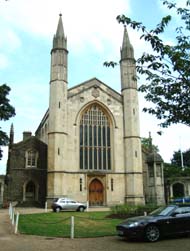
The Danish Church of St Katharine, once the chapel of St Katharine's Hospital. Built of yellow brick in a florid Gothic style, it is an imitation of the chapel of King's College, Cambridge - it forms a pleasant sight from Regent's Park.

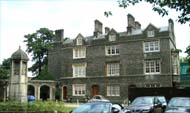
Built of grey brick with stone dressings, the Brothers' House, 1-3 St Katharine's Precinct (left), to the north of the chapel, is similar to the Sisters House, Nos. 6-8 (right) , to the south of the chapel.
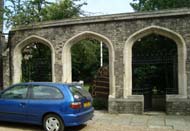

The Houses, the Pastor's House and St Katharine's Church are connected by an arcaded screen wall. A replica of a Jelling Stone - a massive carved runestone - which was made for a London festival in 1955, is situated in the southern arcade.
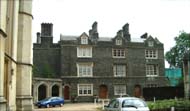

Attached to No. 8 is No 9, the Porter's Lodge, currently undergoing construction work.
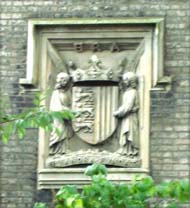
On the Sisters' House are the Royal Arms and, on the Brothers' House, the Arms of the College, with the legend 'Elianora fundat'.

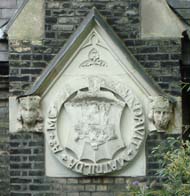
The two lodges bear the same Arms, inscribed 'Fundavit Mathilda, 1548' and 'In hoc situ restitit, 1828'.
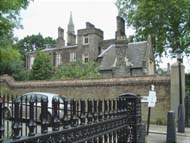
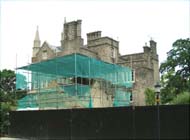
The back of the Brother's House (left) and the back of the Sisters House (right).
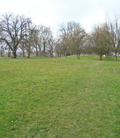

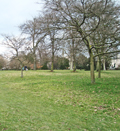
Nothing remains of St Katharine's Lodge, which was destroyed by bombs during the Blitz. The spires of the Danish Church on the other side of the Outer Circle can be seen across Regent's Park (right).
St Katharine's Hospital was refounded in 1914 as the Royal College of St Katharine. It maintained an infant welfare centre in Gillender Street, Poplar, taking over the Manor House, together with the old Bromley Hall next door and two other houses. The Grade II* listed Bromley Hall had housed nursing missions from 1889; the Royal College of St Katharine added a ground floor extension to the building in 1928 which contained a ward and an 'artificial sunlight' department. The Hall was damaged by bombs in 1940.
In 1948 the College was reconstituted as the Royal Foundation of St Katharine and moved to buildings in Butcher Row in Ratcliff, a mile away from its original site.
A new Chapel was dedicated in 1952.
St Katharine is the patroness of scholars. Daughter of the King of Alexandria, she converted to Christianity and, when the Emperor Maximinus ordered her to make a sacrifice to his gods, she refused. For this she was martyred by being broken on a wheel. She is usually depicted wearing a crown and a halo, standing beside a wheel.
The Catherine Wheel firework is named after her.
(Author unstated) 1917 St. Katharine's Lodge Hospital. British Journal of Nursing, 13th October, 239.
Dock LL, Pickett SE, Noyes CD, Clement FF, Fox EG, Van Meter AR 1922 History of American Red Cross Nursing. New York, Macmillan.
Fife GB 1920 The Passing Legions: How the American Red Cross met the American Army in Great Britain, the Gateway to France. New York, Macmillan.
Jamieson C 1952 The History of the Royal Hospital of St Katharine's by the Tower of London. London, Oxford University Press.
http://collage.cityoflondon.gov.uk
http://hansard.millbanksystems.com
http://mapoflondon.uvic.ca
www.ancestryimages.com
www.british-history.ac.uk
www.britishmuseum.org (1)
www.britishmuseum.org (2)
www.diomedia.com
www.history.ac.uk
www.london-footprints.co.uk
www.lookandlearn.com
www.pastscape.org.uk
www.ph.ucla.edu
www.royall.co.uk
Return to home page